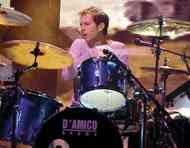Jim Bogios
 Jim Bogios was amazingly calm for someone who was about to perform two huge concerts at separate venues in one night. Earlier this year he was scheduled to perform with The Dixie Chicks at the Universal Ampitheatre in Los Angeles for a Recording Artists Coalition (RAC) benefit. That performance would follow a show at the LA Forum with Sheryl Crow. He’d have to do dual soundchecks and performances in very diverse areas of LA. But Bogios was pumped for it.
Jim Bogios was amazingly calm for someone who was about to perform two huge concerts at separate venues in one night. Earlier this year he was scheduled to perform with The Dixie Chicks at the Universal Ampitheatre in Los Angeles for a Recording Artists Coalition (RAC) benefit. That performance would follow a show at the LA Forum with Sheryl Crow. He’d have to do dual soundchecks and performances in very diverse areas of LA. But Bogios was pumped for it.
While Crow has been Bogios’s main gig for the past few years, he came in contact with The Dixie Chicks when the two acts were on the Lillith Fair tour. And although he juggles a couple of other artists in his off time, Jim maintains that he always sticks to his first commitment, no matter what the offer. “People who jump around for a better gig develop a bad reputation. That always comes back to bite you on the ass.
“There are a million different ways to reach your goals in music,” Jim says, “and every individual must find the path that best suits their needs. For me, private teachers and playing in various bands have been the significant contributors to where I am today.” In 1992 Bogios met up with a band called Papa’s Culture. Jim describes their music as “everything you could imagine. It was the perfect gig for me because it drew upon all the different things I played. It was a rock, jazz, funk, hip-hop, reggae band.” Advertisement
Bogios recorded two albums with Papa’s Culture and remained with them for nearly five years. “The record company didn’t know what to do with us,” he sighs, “or how to promote us. But we grew together as a band. A big part of who I am and the way I play stems from that band. We worked together for a long time and made our living playing great music. Everybody in the band was close. To me, that was success.”
By 1996, though, Papa’s Culture was at a professional standstill. Bogios began pursuing other avenues. The guitar player from the band (David Immergluck, now with Counting Crows) had done a session with Sheryl Crow, and he recommended Bogios for her touring band. Crow management called Jim, and then sent a tape three days before they were going to fly him to LA.
“I had a great session booked,” Jim says, “but I decided to sub it out so I could concentrate on preparing for my audition with Sheryl. I felt that if I wasn’t going to get the gig, it wouldn’t be for lack of preparation. I learned the songs from the tape, and I bought her first record, even though they told me we would only be auditioning from the three songs on the tape, which were going to be on her new record. I learned the first record anyway and wrote out the basic forms of the songs, which is where knowing how to read music comes in handy. When you have these kinds of situations where you have to learn things quickly, reading is invaluable. I put together a cheat sheet and spent as much time as I had on all of the material. Advertisement
“At the audition,” Jim continues, “I was surrounded by a lot of famous drummers who were there to audition. I was an unknown kid from the Bay Area. I was terrified. But once I got into the room and we played music, I was fine. We did a couple of songs from the tape. But then Sheryl started to play stuff from her first album. Not only was I able to play that stuff, but it also showed respect for her because I had learned all of her material. I was like, “Okay, this is how I play.” I also grabbed a mic – and did a little singing while I was playing, which they were happy about. And I got the gig.”
Bogios sings on most of Crow’s material in concert, and he believes that having vocal ability gives a drummer an edge in a roomful of other drummers. He’s been singing since high school. “I always felt it helped me as a drummer,” Jim relates. “My teacher would have me play patterns, and to get a jazz pattern to flow and become second-nature, he would have me read things out loud from a book while playing the pattern. The idea was to get my hands and feet to go on autopilot so whatever I would do with my mouth would not affect my hands. The voice is just like another limb.”
Bogios says that Crow needs him to supply different things on stage. “There are so many things I think a singer needs from a drummer,” he says. “They have to have a tight musical connection. Communication is key. I think the drummer and singer dictate the ebb and flow of every song and of the whole show. And the drummer has to tune in to how the singer is feeling that night. Each night is going to be different, and you’re not going to be able to hit it 100% every night. But if you keep a high percentage, you’ll stick around. Advertisement
“I think the drummer also has to provide the wave that the band rides on,” Jim continues. “If you have a drummer who isn’t strong, there’s a real problem. I think a good drummer knows how to lead, but also how and when to follow.”


